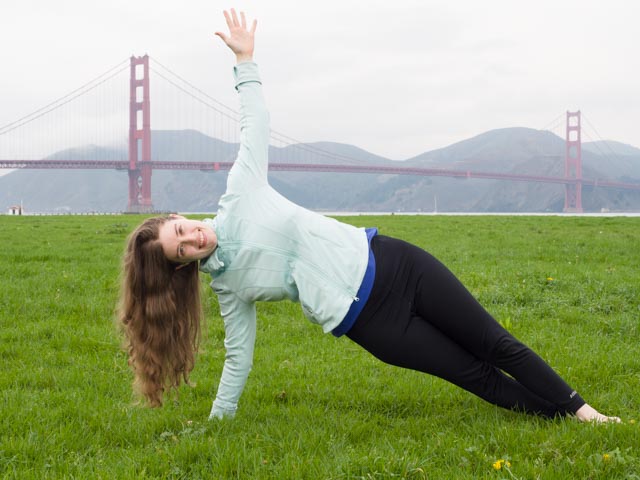How I Got Started in Yoga – and My Teaching Philosophy
By Katharine Bierce, RYT-200 Yoga Teacher
I first took a yoga class as a teenager in an after school program, and sometimes I went to local classes with one of my parents in the New York suburb I grew up in. But I didn’t really get into yoga until after college, when I lived in Manhattan.
I was working 12 hour days in consulting and was incredibly stressed. Although many yoga studios didn’t have classes late at night, Yoga to the People had a 9 pm class that I went to regularly in my consulting days. I remember going in feeling overwhelmed and walking out feeling reborn. Yoga transformed me from a work machine back to a human in just an hour. I had to learn more about how this magic happened.
A few years later, I moved to the San Francisco bay area and joined a teacher training program with Yoga to the People. I almost didn’t finish the program, because I got sick with a bad cold in the middle of it. Between the weekend workshops and weeknight classes, it was 6 days a week of yoga for 10 weeks in a row, and I have never considered myself an athlete. To keep going, I had to redefine what success meant: completing the training, but not being an “A student,” which was in contrast to my over-achiever mindset I’d cultivated from growing up in New York and graduating Phi Beta Kappa from a top university.
Anyway, some time after my first 200 hour training, I became injured and could no longer do the active, dynamic vinyasa practice I had loved, which had gotten me through so much. I didn’t want to give up yoga entirely, but I wasn’t able to do a handstand or 108 sun salutations in a row like I had in teacher training in 2014. I sought a practice that worked with, rather than skipped over, my new limitations, and ended up finding Innerstellar yoga in Berkeley. Innerstellar offers Stellarflow, a hatha/vinyasa style inspired by American yoga teacher Ana Forrest. In Stellarflow I found the answer to “what do I do with an injury?” The answer was to focus on “what part of this CAN I do?” While there are many aspects to Stellarflow, I think my favorite description is “it’s a recipe to undo the effects of computers on our bodies.”
I was also called to explore slower aspects of practice. I completed certifications in yin yoga, where poses are held for 2-5 minutes, and restorative yoga, where Judith Lasater instructed us that “sevasana is 20 minutes MINIMUM!” And a few months after I turned 30, I channeled the ticking of my own biological clock towards completing a prenatal yoga training so that I can offer more support for expecting mothers, too.
To borrow a term from software engineering: I’m a “full stack” yoga teacher, and I enjoy offering customized classes to help tailor whatever life brings to you, to meet you where you’re at. In too many classes, the only modification offered is “just do child’s pose” if something isn’t working for a student. Thanks in part to my own experience with injury as well as multiple trainings, I know lots of ways to sequence a class that can be pain-free or at least pain-free-ing. I also enjoy bringing my problem-solving mindset that serves me well in the technology industry to yoga; the styles, sequences, and modifications I know are what I draw on when creating a customized class to serve students.
I don’t believe there is one perfect style of yoga that everyone should do. Yoga isn’t about looking good in fancy pants (although I do have a few pairs myself!), and it isn’t about achievement or forcing your body into a shape that only causes you more suffering. I believe that yoga should be customizable to what your mind and body need. For more on the goal of yoga, see here. Ahimsa or nonviolence is the first moral principle of yoga, and that includes nonviolence, or practicing kindness to yourself in how you work with your body and mind. Easier said than done, I know! Which is why it’s a practice.
How to Get Started in Yoga
Disclaimer: I am not a doctor, and if you want to start an exercise program, it’s a great idea to talk to a medical professional first!
Many yoga studios have new student discounts. I recommend going to yoga studios near your home or workplace. Try a few different styles.
The second yoga sutra of Patanjali says: Yoga citta vritti nirodha, which means “Yoga is the settling of the mind into stillness” or “Yoga is the cessation of the fluctuations of the mind.” Whatever practice helps you focus the mind and find balance between strength and ease in the body: do that.
If you travel a lot for work and getting to in-person classes can be tough, consider taking classes online. Video recordings can be one way to get started, but if you’re annoyed by YouTube ads or get bored of the same sequence all the time, consider a live one-on-one class to help you meet you where you’re at. I offer live online classes customized to you, whether you’re already strong and want to improve your flexibility or if you’re finishing up physical therapy and want to bring more yoga back into your life.
Email me at info@businesscasualyoga.com to learn more!

